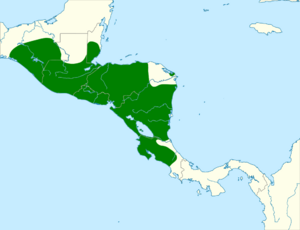Cabanis's wren facts for kids
Quick facts for kids Cabanis's wren |
|
|---|---|
 |
|
| In Chiapas, Mexico | |
| Conservation status | |
| Scientific classification | |
| Genus: |
Cantorchilus
|
| Species: |
modestus
|
 |
|
| Synonyms | |
|
Thryothorus modestus |
|
The Cabanis's wren (scientific name: Cantorchilus modestus) is a small bird that belongs to the wren family, Troglodytidae. You can find this bird in several countries in Central America, including Belize, Costa Rica, El Salvador, Guatemala, Honduras, Mexico, and Nicaragua.
Contents
What Makes Cabanis's Wren Special?
For a long time, the Cabanis's wren was thought to be the same as two other types of wrens, the canebrake wren and the isthmian wren. Together, they were all called the "plain wren."
However, in 2016, scientists decided they were actually different species. This decision was made after studying their unique songs and looking at their DNA. So, now the Cabanis's wren is considered its own special species!
What Does Cabanis's Wren Look Like?
Cabanis's wrens are small birds, usually about 12.5 to 14 centimeters (about 5 to 5.5 inches) long. They weigh about as much as a few paper clips!
- Head: They have a dark gray-brown top of the head.
- Back: Their back is a reddish-brown color.
- Tail: Their tail is also reddish-brown with thin, darker stripes.
- Eyes: You might notice a white stripe above their eyes, like an eyebrow. There's also a gray-brown stripe behind their eyes.
- Cheeks: Their cheeks have a mix of gray-brown and gray-white colors.
- Underparts: Their throat is white, their chest is a light grayish-tan, and their belly is a creamy white. The sides of their body are a bit more orange-tan.
Birds living in the northern parts of their home range tend to have darker backs. Young Cabanis's wrens look similar to the adults but are a bit duller in color.
Where Does Cabanis's Wren Live?
This wren lives in a wide area, starting from the Mexican states of Oaxaca and Chiapas. From there, its home stretches south through Belize, Guatemala, El Salvador, Honduras, and Nicaragua. It even reaches the Pacific coast of central Costa Rica.
Cabanis's wrens are quite adaptable! They can live in both dry and humid places. You can find them in many different environments, such as:
- The edges of forests
- Areas where new plants are growing after old ones were cleared (called "second growth")
- Even in gardens!
They can live anywhere from sea level up to about 2,000 meters (about 6,500 feet) high in the mountains.
How Does Cabanis's Wren Behave?
What Do They Eat?
Cabanis's wrens usually look for food in pairs. They like to search in low, thick plants and bushes. Sometimes, they will hunt higher up in trees. Their main diet is made up of insects and spiders.
How Do They Build Nests?
The nest of a Cabanis's wren looks a bit like a football! It's made from grass and other plant fibers, and the inside is lined with softer materials to make it cozy. The nest has an entrance hole on the side.
They usually build their nests in thick plants, less than 3 meters (about 10 feet) off the ground. Most often, a female wren will lay two eggs, but sometimes they lay three.
What Do They Sound Like?
Cabanis's wrens are known for their loud and clear songs. Their song is often described as "a loud motif of 3–4 clear whistles" [1].
They also have different calls:
- A harsh sound that sounds like "chur" [2].
- A rippling, tinkling sound that goes "chi-cho-chi" [3].
Is Cabanis's Wren in Danger?
The International Union for Conservation of Nature (IUCN) has looked at the Cabanis's wren and decided it is a species of "Least Concern." This means that there are plenty of these birds around, and they are not currently at risk of disappearing. They even do well in places where humans have changed the landscape, like in gardens or areas with new growth.


